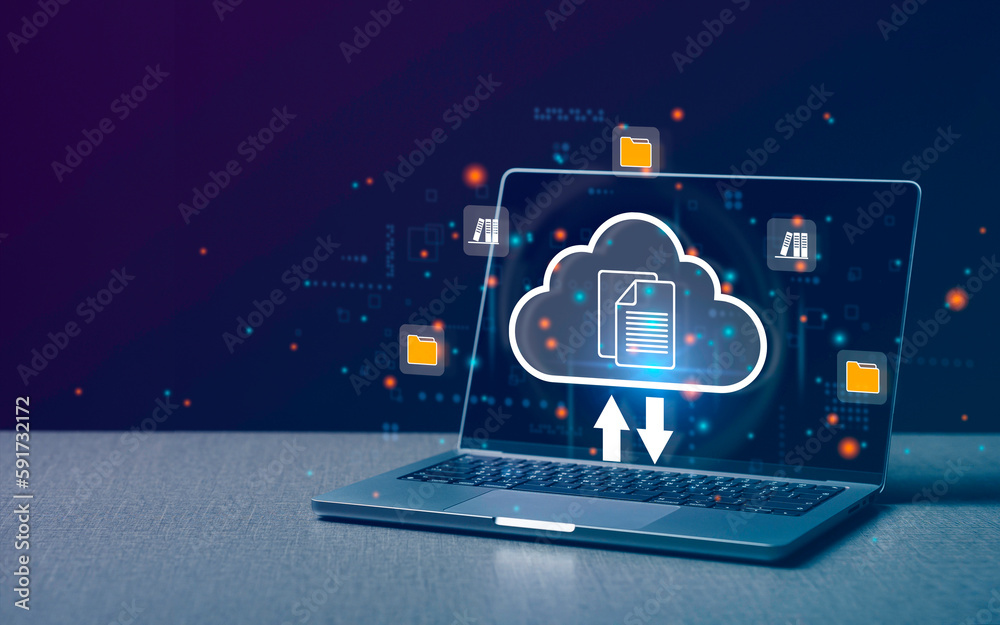Cloud vs Local Backup: An In-depth Comparison for Secure File Storage
In today’s digitally driven world, the significance of secure file storage cannot be overstated. Data, in the form of documents, photos, videos, and critical business information, plays a pivotal role in our personal and professional lives. As we generate and accumulate increasing amounts of data, ensuring its safety and accessibility becomes a paramount concern.
Backing up data is a practice that addresses the potential loss or corruption of important files due to hardware failures, accidental deletion, cyberattacks, or other unforeseen events. The need for a reliable backup solution has become more pressing than ever, given the increasing frequency and sophistication of cyber threats. A robust backup strategy not only safeguards against data loss but also provides a sense of peace knowing that vital information remains intact.
In this article, we will delve into the primary concerns associated with data backup and explore the pros and cons of two prominent options: Cloud and Local Backup. These two approaches have emerged as popular choices for individuals and organizations seeking to fortify their data protection strategies. By comparing their features, security measures, accessibility, and ease of use, readers will gain a comprehensive understanding of which solution best aligns with their specific needs.
Understanding Cloud Backup

What is Cloud Backup?
Definition and overview
Cloud backup, also known as online backup or remote backup, is a method of data storage that involves uploading and storing files on remote servers hosted by third-party service providers. These servers are typically located in data centers with redundant infrastructure and robust security measures. It’s services offer users the convenience of accessing their data from any internet-connected device, providing an off-site solution for data protection.
Benefits and drawbacks
Users can access their backed-up data from anywhere with an internet connection, facilitating easy retrieval and restoration. Cloud backup services often provide automated scheduling, ensuring that data is regularly and consistently backed up without manual intervention. Data is stored off-site, offering protection against physical disasters like fires, floods, and theft at the primary location. Cloud storage can be easily scaled up or down based on storage needs, providing flexibility as data volumes change. Isolutions usually support various operating systems and devices, making them suitable for diverse environments.
Cloud backup requires a stable internet connection for uploading and downloading data, which might be an issue in areas with limited connectivity. Storing data on remote servers raises security concerns. While reputable providers implement robust security measures, there is still a degree of reliance on the provider’s practices. Cost Considerations: Depending on the amount of data being backed up, cloud storage costs can accumulate over time. Initial backups and large restores might be time-consuming due to data transfer speeds over the internet.
How Cloud Backup Works
Technologies and methods
Cloud backup employs several technologies and methods to ensure efficient and secure data storage and retrieval.
Incremental Backup: In an incremental backup strategy, only new or modified data since the last backup is copied to the cloud. This approach reduces the amount of data transferred and shortens backup times compared to full backups.
Differential Backup: Differential backup captures all changes made since the last full backup. Unlike incremental backups, which only consider changes since the last backup, differential backups accumulate changes from each backup, which can result in larger backup files over time.
Block-Level Backup: Many cloud backup systems use block-level backup techniques. This involves breaking files into smaller blocks, and only the changed blocks are backed up, reducing the time and bandwidth required for backups.
Deduplication: Deduplication eliminates duplicate data blocks to save storage space. If multiple files or backups contain the same data, the cloud backup service will store just one instance of that data, reducing the overall storage footprint.
Security measures
Security is a critical aspect of cloud backup services, as users entrust their valuable data to third-party providers. To protect data from unauthorized access and potential breaches, reputable cloud backup providers implement robust security measures.
Data is encrypted both during transit (while being uploaded or downloaded) and at rest (while stored on the servers). This encryption ensures that even if data is intercepted, it remains unintelligible without the decryption keys. Cloud backup providers usually store data in highly secure data centers equipped with physical security measures like surveillance cameras, access control systems, and biometric authentication. User authentication mechanisms, such as strong passwords or multi-factor authentication, ensure that only authorized users can access and manage their backups. Some cloud backup providers offer the option for users to use their private encryption keys. This means that even the service provider cannot access the data without the user’s decryption key. Reputable providers often undergo third-party audits and adhere to industry standards and regulations like GDPR (General Data Protection Regulation) or HIPAA (Health Insurance Portability and Accountability Act) to ensure data security and privacy.
By implementing these technologies and security measures, cloud backup services strive to provide a reliable and secure environment for users to store and protect their valuable data.
Who Should Use Cloud Backup?
Cloud backup is a versatile solution that caters to a wide range of individuals, businesses, and industries. Here are some suitable use cases and industries where cloud backup can be particularly advantageous.
Individuals and Families: Cloud backup is ideal for protecting personal documents, photos, videos, and other digital assets that hold sentimental or practical value. Cloud backup allows users to access their data from various devices, ensuring data availability even if a device is lost, stolen, or damaged. It offers a user-friendly way to secure data without requiring advanced technical expertise.
Small and Medium-Sized Businesses (SMBs): SMBs can safeguard critical business documents, financial records, customer data, and operational files from potential threats like hardware failures, cyberattacks, and accidental deletions. Cloud backup provides off-site data storage, ensuring that important data remains safe even in the event of on-site disasters. SMBs can avoid the high upfront costs of setting up on-premises backup infrastructure by opting for scalable and subscription-based cloud backup plans.
Remote Workers and Digital Nomads: Cloud backup allows individuals working remotely to access their files from various locations, ensuring seamless collaboration and productivity. Remote workers can switch devices while maintaining access to their data, enhancing flexibility and adaptability.
Mobile Workforce: Cloud backup ensures that files are synchronized across devices, allowing mobile employees to access the most up-to-date information on the go. In case of device loss or damage, employees can quickly restore their work-related data to a new device.
Startups and Entrepreneurs: Cloud backup solutions can easily scale to accommodate increasing data volumes as startups grow. Cloud backup eliminates the need for upfront investments in physical hardware, making it a cost-effective option for resource-constrained startups.
Understanding Local Backup

What is Local Backup?
Definition and overview
Local backup, often referred to as on-premises backup or offline backup, involves storing data on physical devices located at the same physical location as the data source. These devices can include external hard drives, network-attached storage (NAS) systems, dedicated backup servers, or even tapes. Unlike cloud backup, which relies on remote servers, local backup keeps data within the user’s direct control.
Benefits and drawbacks
Users have direct control over their data, reducing reliance on third-party providers and potential security concerns. Local backup can offer faster backup and restore speeds compared to cloud backup due to the absence of internet bandwidth limitations. Local backups do not require an internet connection, making them accessible even in areas with limited connectivity. There are no ongoing subscription costs associated with local backup solutions, aside from the initial investment in hardware and software.
Data stored locally is susceptible to the same physical disasters that could impact the primary location, such as fires, floods, or theft. Local backups lack the off-site redundancy that cloud backup offers, which can be a concern if the primary location is compromised. Managing and maintaining local backup hardware and software, as well as scaling storage capacity, requires ongoing effort and investment. Regular manual backups are required to keep data up to date, unlike automated cloud backup solutions.
How Local Backup Works
Technologies and methods
Local backup methods and technologies vary, but they generally involve copying data from the source system to a storage device. Common methods include these things.
Full Backup: All data is copied to the backup device in its entirety. This provides a complete snapshot of the data but can be time and resource-intensive.
Incremental Backup: Only new or modified data since the last backup is copied. Incremental backups are quicker than full backups but require multiple backups for complete data restoration.
Differential Backup: Similar to incremental backup, but instead of copying only new data, differential backup captures all changes since the last full backup.
Security measures
Local backup security largely depends on physical security measures and encryption.
Physical Security: Protecting the backup devices from theft, unauthorized access, and physical damage is crucial. Safeguarding the backup location with locks, restricted access, and alarms enhances security.
Encryption: Encrypting data on the backup device helps prevent unauthorized access in case the device is lost or stolen. However, managing encryption keys is critical to ensure data accessibility.
Who Should Use Local Backup?
Local backup is suitable for various scenarios and industries that prioritize data control, faster access, and offline protection.
Individuals concerned about data privacy and security may prefer local backup to keep their data under direct control. Businesses located in areas with unreliable or slow internet connections can benefit from local backup’s independence from internet access. Businesses dealing with large volumes of data may find local backup more practical due to faster backup and restore speeds. Industries such as finance and healthcare, where data regulations mandate tight control over data, may opt for local backup solutions.
Entities handling sensitive or classified data may prefer to maintain full control over their backups to minimize external exposure. Areas with frequent internet outages or limited connectivity may find local backup more reliable for data protection. Organizations relying on critical systems may use local backup as a redundancy strategy alongside other backup methods.
In-Depth Comparison
Cost Comparison
Cloud backup typically involves subscription-based pricing models, where users pay a recurring fee based on the amount of data being backed up and stored. The cost can increase as data volume grows, which might result in higher expenses over time. Some cloud providers offer tiered plans with varying storage capacities, allowing users to choose a plan that suits their needs.
Initial costs for local backup include purchasing hardware such as external hard drives, NAS devices, or backup servers. There are no ongoing subscription costs, but hardware maintenance, upgrades, and potential replacement costs should be considered. Local backup can become more cost-effective over time if hardware investments are spread out.
Security Comparison
Cloud Backup Security: Reputable cloud providers employ advanced encryption techniques to secure data during transfer and while at rest. Data centers are equipped with physical security measures and redundancy to ensure data availability and protection. Some cloud providers offer private encryption keys, giving users more control over data security.
Local Backup Security: Data stored on local devices is primarily secured through physical security measures, like locks and access restrictions. Users have direct control over their data and encryption, but the responsibility for implementing strong security practices lies with them.
Accessibility and Flexibility
Cloud backup offers the advantage of accessing data from anywhere with an internet connection. Users can retrieve their files using various devices, including computers, smartphones, and tablets. Changes made on one device are often automatically synced across other devices connected to the same cloud backup account. This ensures that the latest version of data is available on all devices. Cloud backup facilitates seamless collaboration, as multiple users can access and edit shared files in real-time. This is particularly useful for remote teams or individuals working together on projects. Many cloud backup services offer automated scheduling for backups, reducing the need for manual intervention and ensuring data is consistently protected. Cloud backup is highly scalable. Users can easily upgrade their storage plans as their data needs grow without worrying about hardware limitations.
Local backup devices need to be physically accessed to retrieve data. This can be limiting, especially if the backup devices are located in a different place than the user’s current location. Data syncing across devices requires manual effort, and changes made on one device might not immediately reflect on others without manual synchronization. Collaboration is more challenging with local backup, as sharing and editing files in real-time may require additional steps like manual file transfers or shared network access. Users need to initiate manual backups at regular intervals. This requires remembering to perform backups and might lead to gaps in data protection if backups are forgotten. Local backup solutions are limited by the storage capacity of the chosen hardware. As data grows, users may need to invest in additional hardware.
Performance and Speed
Cloud backup speeds are influenced by internet connection bandwidth. Uploading and downloading large amounts of data can be slower if the internet connection is not high-speed or stable. The first backup to the cloud can take a significant amount of time, especially if a large volume of data needs to be uploaded. The duration depends on both data size and internet speed. Subsequent backups are faster due to the incremental backup approach, which only transfers changed or new data since the last backup. Data restoration can also be impacted by internet speeds, particularly for large data sets. However, restoration times can vary depending on the cloud provider’s infrastructure.
Local backup speeds are typically faster than cloud backup speeds because data is transferred over local networks or directly from devices. Local data transfer is not constrained by internet bandwidth. Initial backups are generally faster since data is transferred over local connections, allowing for quicker completion compared to cloud-based transfers. Similar to cloud backup, local incremental backups are quicker since only changes since the last backup need to be transferred. Restoring data from a local backup is generally faster than restoring from a cloud backup due to the faster data transfer speeds within a local network.
Compliance and Regulation Considerations
Cloud backup providers might store data in data centers located in various jurisdictions. This can raise concerns about data privacy and compliance with local regulations. Cloud providers often adhere to industry-specific regulations such as GDPR (European Union’s General Data Protection Regulation) or HIPAA (Health Insurance Portability and Accountability Act) for healthcare data. This can be advantageous for businesses that handle regulated data. Users should ensure that their chosen cloud provider complies with the relevant regulations and offers adequate data protection measures. Many providers undergo third-party audits to demonstrate compliance.
Local backup offers users more direct control over their data’s compliance. Users can implement measures to ensure data security and adherence to relevant regulations. Users are solely responsible for ensuring their local backup practices align with relevant data protection regulations. This includes implementing encryption, access controls, and proper physical security.
Compliance and regulation considerations play a significant role in determining the suitable backup solution. Businesses and individuals should assess their industry-specific regulations, the jurisdiction of their data, and the level of control they desire over compliance practices when making a decision between cloud and local backup.
Use Cases and Scenarios
Certainly, let’s explore some real-world scenarios in the context of Canberra, Australia, where either Cloud Backup or Local Backup might be preferable based on different business sizes and industries.
Scenario 1: Small Startup in Canberra
Business Size: Small startup with limited resources.
Preference: Cloud Backup.
Reasoning: Cloud backup offers scalability without upfront infrastructure costs. A startup can benefit from off-site data protection and easy collaboration, which are essential for growth. Since startups often focus on agility, cloud backup allows remote access and ensures data availability even if office hardware fails.
Scenario 2: Healthcare Clinic in Canberra
Business Size: Medium-sized healthcare clinic.
Preference: Local Backup.
Reasoning: Healthcare data is subject to strict regulations, and local backup provides more direct control over compliance and security measures. Patient records and sensitive data can be stored securely on-site, ensuring compliance with privacy regulations while minimizing the risk of unauthorized access.
Scenario 3: Creative Agency in Canberra
Business Size: Creative agency with multiple design projects.
Preference: Cloud Backup.
Reasoning: Cloud backup facilitates collaboration among designers who work remotely or across different locations. Creative files can be accessed and edited from various devices, making it easier for designers to collaborate on projects, irrespective of their physical location.
Scenario 4: Legal Firm in Canberra
Business Size: Law firm dealing with sensitive client information.
Preference: Local Backup.
Reasoning: Legal firms handle confidential and sensitive client data. Local backup allows direct control over data access and encryption, enabling the firm to maintain compliance with legal data protection regulations while minimizing the risk of data breaches.
Scenario 5: Retail Chain in Canberra
Business Size: Retail chain with multiple locations.
Preference: Cloud Backup.
Reasoning: Retail chains benefit from the accessibility of cloud backup. Inventory data, sales reports, and other crucial business information can be accessed and updated from various locations. Cloud backup ensures that data remains consistent across all branches, enhancing operational efficiency.
Scenario 6: Educational Institution in Canberra
Business Size: University campus.
Preference: Local Backup.
Reasoning: Educational institutions often manage vast amounts of sensitive student and faculty data. Local backup allows for on-site data storage, providing control over security measures and compliance practices. This approach ensures that data remains within the institution’s control while minimizing risks associated with external cloud services.
These scenarios illustrate that the choice between Cloud Backup and Local Backup depends on various factors, including business size, industry regulations, data sensitivity, and collaboration needs. Canberra’s diverse business landscape highlights the importance of tailoring backup solutions to specific requirements, ensuring data protection and accessibility align with each business’s unique priorities.
Conclusion
In the journey to safeguard data, the choice between Cloud Backup and Local Backup hinges on a multitude of factors, each catering to distinct needs and constraints. Through an in-depth comparison, we’ve uncovered key findings that can guide decision-making.
Explore TechBox for your trusted backup service provider in Canberra. For Canberra businesses seeking a reliable backup solution, look no further than TechBox. We provide state-of-the-art Cloud Backup services tailored to your unique needs. Contact TechBox now to safeguard your business’s valuable information and ensure a resilient data protection strategy for your future.










